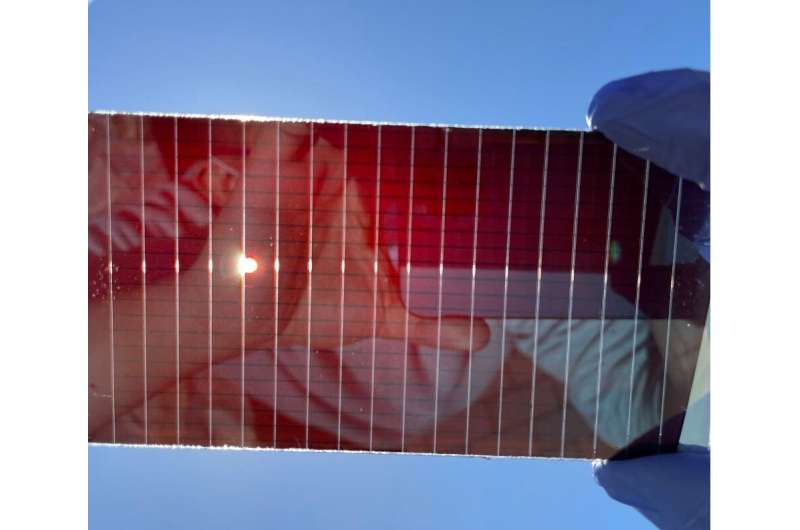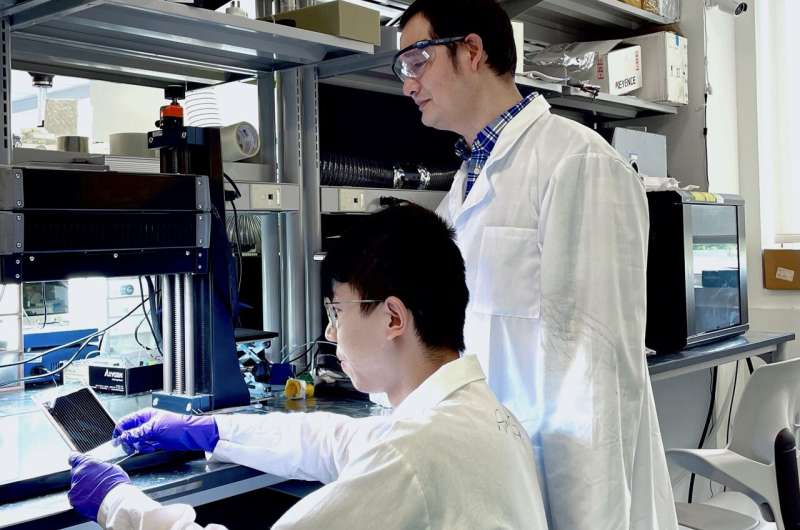New design strategies to improve the stability and efficiency of bifacial perovskite solar cells

Solar cells based on perovskites, calcium titanium oxide minerals or compounds with similar structures, are among the most promising emerging energy solutions. Over the past few years, engineers and material scientists have been exploring the potential of solar mini-modules (i.e., small cells that can be used to create larger-scale solar panels) made of perovskite bifacial structures.
As suggested by their name, these flat structures have perovskite materials on both their front and back side, with the first harvesting direct sunlight and the latter light that is reflected on surfaces (i.e., albedo light). While solar mini modules based on perovskite bifacial structures could achieve greater power conversion efficiencies (PCEs) than conventional perovskite solar cells, effectively designing them has so far proved challenging.
Researchers at University of North Carolina at Chapel Hill recently introduced new design strategies that could help to improve the efficiency and stability of bifacial perovskite solar cells. Using these techniques, outlined in Nature Energy, they developed new solar mini-modules that achieved remarkable performances.
“Perovskites solar cells are booming with quickly rising efficiencies and commercialization of them are moving fast globally, but there are still many remaining challenges to overcome, including low stability and the derate of efficiency when transferring from lab-scale small cells to large-area modules,” Jinsong Huang, one of the researchers who carried out the study, told Tech Xplore. “One uncertainty is whether the cost-saving of using low-cost perovskites and deposition processes is sufficient to compete with fossil fuel-based energy.”
By simultaneously harvesting both direct sunlight and albedo light, bifacial solar cells could improve the energy yield of solar technologies. So far, however, researchers only developed a few bifacial perovskite cells and modules, and existing ones exhibited far lower efficiencies than their mono-facial counterparts.

“The goal of our recent work was to demonstrate perovskite bifacial minimodule with high energy yield and long operational lifetime,” Huang said. “The main strategies we propose for the design optimization of bifacial perovskite modules include a newly designed module structure and rear electrode, adding hydrophobic additives for improved moisture stability, and enhancing long-wavelength light absorption with embedded dielectric nanoparticles.”
Huang and his colleagues firstly designed a bifacial structure in which individual sub-cells are connected by indium tin oxide (ITO), and with silver grids that are separated by an optimal space on the rear ITO electrode to reduce resistance loss (i.e., the loss of electrical energy that can occur when a current flows inside wires). This design is straightforward and scalable, which means that it could enable the large-scale fabrication and commercialization of perovskite bifacial mini-modules.
“We also found that adding tris(pentafluorophenyl)borane (TPFB) as an additive in the hole transport layer obviously alleviate the damage of moisture to the perovskite film during the process of SnO2 deposition,” Huang explained.
“Besides, the addition of TPFB decreased resistivity of hole transport layer and enhanced the energy alignment. Finally, we introduced nanoparticles (NPs) into the perovskite to scatter the incident sunlight, thereby increasing the optical path to overcome their absorption loss particularly in long wavelength range in bifacial modules.”
Using their proposed design, the researchers developed small area bifacial perovskite solar cells that achieved a power generation density of 26.4 mW cm-2 and bifacial minimodules that achieved a power generation density of 23 mW cm-2 , when exposed to direct sunlight on one side and an albedo illumination of 0.2 on the other. These results are significantly better than the power generation densities exhibited by both previously developed perovskite single-junction solar cells and minimodules.
Remarkably, the prototype minimodule developed by the team was also found to achieve a remarkably operational stability, only losing 3% of its initial efficiency after working for more than 6,000 hours. Combined, the design strategies introduced by this team of researchers could thus pave the way towards the large-scale fabrication of highly efficient and stable solar energy solutions based on bifacial perovskite structures.
“While some companies may already be working on commercializing perovskite bifacial solar cells, this work affirms the promising potential of these bifacial structures,” Huang added. “We would now like to identify new strategies to continually improve the energy yield and stability of bifacial perovskite solar modules.”
More information:
Hangyu Gu et al, Design optimization of bifacial perovskite minimodules for improved efficiency and stability, Nature Energy (2023). DOI: 10.1038/s41560-023-01254-3
© 2023 Science X Network
Citation:
New design strategies to improve the stability and efficiency of bifacial perovskite solar cells (2023, May 15)
retrieved 15 May 2023
from https://techxplore.com/news/2023-05-strategies-stability-efficiency-bifacial-perovskite.html
This document is subject to copyright. Apart from any fair dealing for the purpose of private study or research, no
part may be reproduced without the written permission. The content is provided for information purposes only.
For all the latest Technology News Click Here
For the latest news and updates, follow us on Google News.
